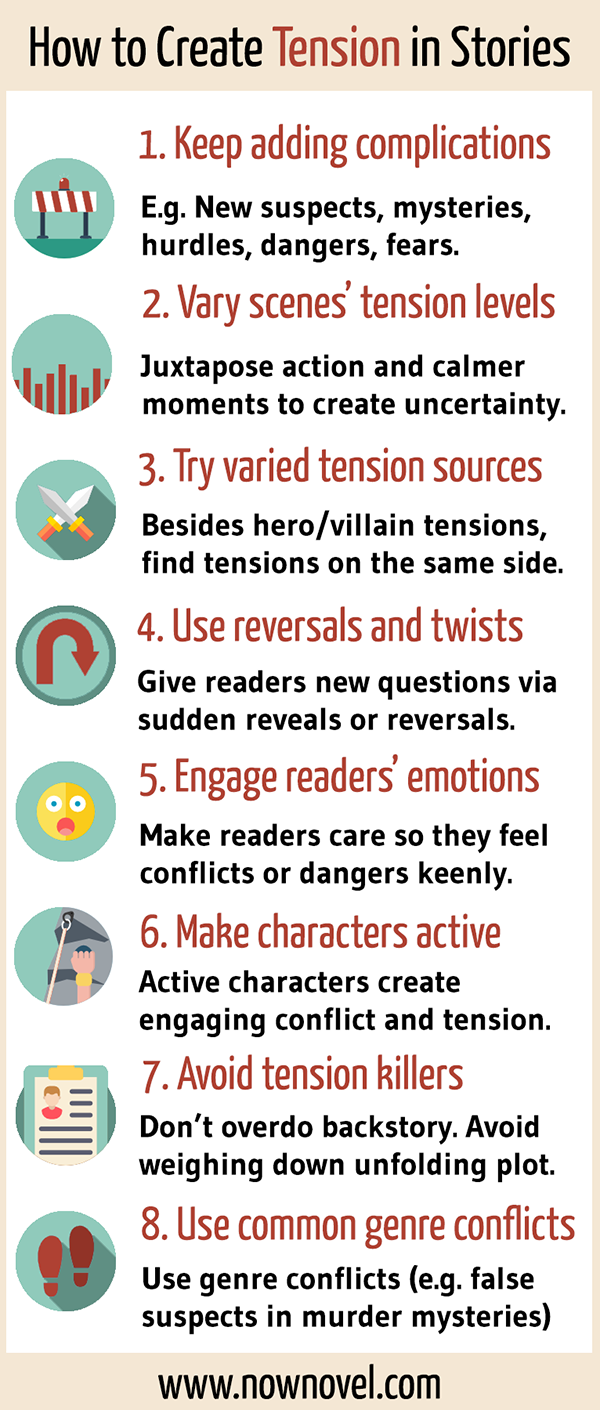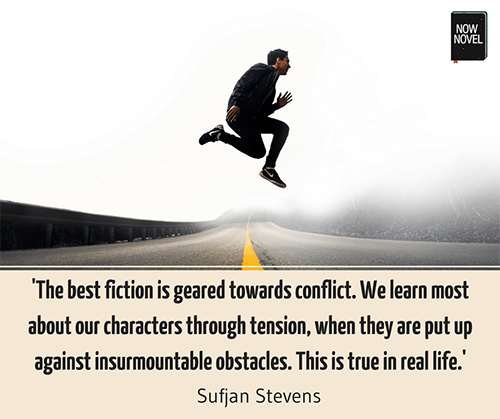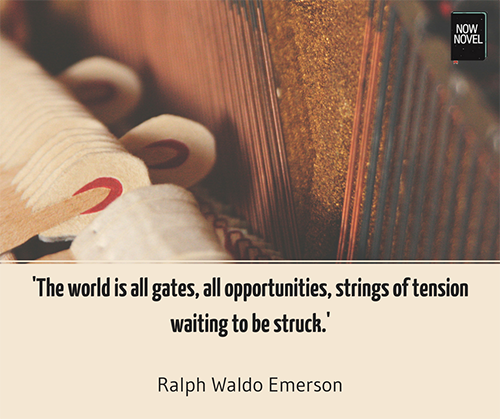Suspense and tension are essential for a page-turner. What are some techniques writers use for increasing tension in the rising action of a story or novel? Read these tips to build tension that keeps your reader intrigued and invested in your story arcs:
First, what is narrative tension?
The word ‘tension’ itself comes from the latin meaning ‘to stretch’ (OED). When things stretch too far, they snap or break. It’s the same in a tense relationship, conflict, or story scenario. Tension is a state of uncertainty, and the anxiety it attracts. It’s like watching a tightrope walker wobble slowly on a thin line between mountain peaks.
The multiple definitions of ‘tension’ remind us of the many forms of tension you can create in a story.
- The state of being stretched tight
- Mental or emotional strain
- A strained political or social state or relationship
- A relationship between ideas or qualities with conflicting demands or implications
A scene involving a tightrope walker gives us the tension of the first definition, as well as the second. The rope is stretched tight. The walker has the psychological strain of focusing on the task. We have the emotional strain of hoping she doesn’t fall.
In a relationship where two characters have conflicting demands or desires, we see mental or emotional strain when opposition devolves into conflict.
Keeping these definitions in mind, let’s examine techniques to build tension in your writing:
1. Keep adding complications to characters’ arcs
Raising the stakes and complicating the situation for your protagonist is one of the most basic ways to create and maintain tension in a novel.
In a thriller or crime novel, particularly, the situation typically grows increasingly dire for the protagonist. Escalating tension is one of the four most important factors of writing effective suspense, so your hero’s (or anti-hero’s) efforts to fix problems should sometimes fail.
For example, Fyodor Dostoevsky’s classic crime novel Crime and Punishment (1866) explores the tragedy that unfolds when a penniless, troubled student murders a greedy pawnbroker. The murder scene occurs early in the novel. Yet the protagonist, Raskolnikov, is not aware that the victim’s sister, Lizaveta, has entered the victim’s apartment while he is rummaging for valuables to sell:
Suddenly he jumped up, seized the axe and ran out of the bedroom.
In the middle of the room stood Lizaveta with a big bundle in her arms. She was gazing in stupefaction at her murdered sister, white as a sheet and seeming not to have the strength to cry out. (p. 71)
The cliched metaphor ‘white as a sheet’ aside, this complication effectively adds tension. Raskolnikov has justified murdering the pawnbroker to himself, yet there is no way even he can justify killing her generous, ‘innocent’ (by his standards) sister.
Dostoevsky introduces two kinds of tension: tension between Raskolnikov’s beliefs (his rationalization of his deeds falls apart as Lizaveta cannot fit it) and the tension of the emotional and mental strain resulting from his committing double murder.
Dostoevsky piles on even further tension as we learn that handymen were renovating a nearby apartment and thus there were possible witnesses to Raskolnikov’s departure. These events add tension due to dramatic unknowns and the potential impact they might still have. We wonder how things will turn out and Dostoevsky uses this uncertainty to create tension and dread.
Here are some other points to keep in mind when you are using complications to build tension:
2. Balance high dramatic tension with calmer scenes
When you create obstacles for characters that build tension, they should be of different sizes. Varying the amount of tension added by complications will create variety and small climaxes and releases that make the main conflicts in your novel that much more powerful. Your reader will have questions they need more urgently answered than others. As writer Lee Child says in The New York Times, ‘As novelists, we should ask or imply a question at the beginning of the story, and then we should delay the answer.’
When reviewing a first draft, it’s a good idea to take notes on where you have included scenes that introduce additional tension and complications. Make sure the larger-stake issues are not all introduced and solved well before the climax. In fact, a climax can introduce one or more additional complications that keep suspense taut to the end of your story.
In addition to varying the degree of tension you introduce in conflict and suspenseful scenes, alternate tense scenes or sequences with calmer moments. Contrast is key to keeping your reader interested. A perpetual state of suspense is a difficult , stress-laden emotional state to maintain.
In very short novels that have simple stories set within a short period of time, it might be possible to keep the tension high throughout, but more often, both your reader and protagonists may need time to catch their breath. For example, in Tolkien’s LOTR cycle, after the stressful, life-and-death conflict scene as his heroes pass through the Mines of Moria, we read of their stay in the Elves’ peaceful land of Lothlórien. This story segment gives us a break from the emotional intensity of the preceding action.

3. Draw story tension from varied places
When we think about creating tension in storytelling, we generally think in terms of protagonists and antagonists; heroes and villains. But remember to create moments of tension between characters who otherwise get along, as well as internal tension.
For example, in a romance novel, in addition to the conflicts that keep the protagonist apart from their love interest, they might have additional conflicts with their sister or best friend. Perhaps your character is moody or glum about their lover’s distance or silence and snaps at others. Secondary, lesser or passing tensions help to keep subplots as interesting as main story and character arcs.
Character-driven TV thrillers offer many examples of effective tension building. In Showtime’s political thriller series Homeland, the main character, Carrie, chooses to go abroad on dangerous CIA assignments. This is partially due to her committed, emotional investment in her work. Yet she also does so to avoid her fear of being an unfit parent to her child, as she struggles with her mental health. This creates a sense of there being unresolved internal conflicts in her life that leave viewers staying on for resolution. The story’s tension is strong, even when it’s a solo scene, for this reason.

4. Use reversals, twists and revelations effectively
These are all excellent ways to heighten tension in a novel.
Some incidents may be two or all three of these things at the same time. For example, the moment that Luke Skywalker learns the infamous, shocking truth about Darth Vader, the main villain in George Lucas’s Star Wars, is both a twist and a revelation. We don’t see this coming although it has been set up from the start in a number of ways.
A famous reversal from classic cinema comes near the end of Casablanca when Ilsa learns Rick is not coming with her. A well-timed plot twist may plunge your characters into uncertainties that we as readers (or viewers) experience as tense suspense.
5. Appeal to readers’ emotions
One important point to keep in mind regarding tension is that it is not the size of the stakes but how invested the reader is in those stakes that matters. When deciding how to create tension in your plot, include emotion. Well-developed characters are critical for readers to become emotionally invested. Most passionate readers know the feeling of finishing a good book and feeling bereft without characters who came to feel like friends. Developing believable and engaging characters who are invested in their goals may seem unrelated to the task of building tension, but it is actually one of the most essential elements for creating this effect.
How else can you create tension in your writing?
6. Increase tension in your writing by making characters active
Active characters make things happen. They react, but they are also proactive. Passive characters let things happen to them. Passive characters are usually not the protagonist (except in tragedies), and they rarely create tension through outward action. Internal conflicts are usually the primary source of tension where these fictional characters are concerned.
Readers tend to like active characters better than passive characters. It’s hard to have much sympathy for characters who simply sit and wait for fate to overtake them.
When active characters keep trying to solve their problems and keep taking missteps, story tension mounts. In a historical romance where two characters are separated by a work assignment, a war or another force, they might write letters, for example. They actively try to overcome the obstacle.
Scenarios like these introduce more opportunities for mishaps and tension. You could, for example, have an entire chapter telling the story of a love letter’s progress as it’s misplaced, wrongfully delivered, returned to sender, and finally reaches its destination. Here, the tension is still between two characters but is shifted onto their communication itself and whether or not it reaches its target.

7. Avoid tension destroyers
There are a few things you should not do or only do sparingly in order to maintain tension:
- Don’t overdo backstory. Your characters had lives before the story started, and sometimes it is necessary to explain your character’s psychology and even to build tension by informing your readers of some of that history. However, too much backstory may drag your novel to a halt
- Don’t tell the reader everything. Tighten your writing. You might have noticed that people in movies and TV shows rarely say goodbye; they just hang up the phone. Of course, you wouldn’t do this in real life, but in a movie, it cuts any fat from the scene. Books are no different. Your reader doesn’t need to have every line of dialogue two characters speak or to know how someone got from one place to another. Stick to key information
- Don’t waste time idling. The tension might be building quickly or very slowly, but the story should always be moving forward in some way, eliciting questions of ‘what next?’ Whenever you write a scene, ask yourself ‘what key piece of the whole does this contribute?’
8. Ground your tension in conflicts that make sense for your genre
All novels need tension, but different types of stories produce tension from different sources.
The main tension in a romance novel will come from whether or not the protagonist and the love interest get together, or struggles they face with each other or facing external events. The main tension in a crime novel involves solving the mystery or catching a criminal. In a similar way to the tip about steadily raising the stakes, this may seem like an obvious observation. Yet often a novel that falls flat has forgotten to focus on what should be the main source of tension, the most urgent unknown.
Once you’ve made certain that you have chosen an effective main source of tension, you can also look to other genre elements to create secondary tension. Your detective in a mystery novel might also be struggling with a romantic relationship. Characters fighting to save their home in a family saga might deal with a murder. Just be sure that you don’t let secondary sources of tension seem like they usurp and detract from the main conflicts of your story.
Structuring your story well is vital if you want to create masterful tension. Try the structured Now Novel process to create a novel outline and stay focused on key, tension-building events.


11 replies on “How to create tension in writing: 8 methods”
Thank you for this post! This is exactly what I needed! You just made my life so much less stressful.
One technique I use that works really well is to imagine the book as a
season in a TV show. I look at each chapter as an episode, and remember
the best shows I’ve ever watched. Namely Fringe.
So each chapter, or
episode, must further the overall plot of the season and show (If you’re
writing a series of books) and present tension for that. But it must
have tension of its own which is at least partially resolved by the end
of the chapter/episode.
It’s REALLY helpful. To me, at least.
Thanks Charlie, I’m really glad you found it helpful. That sounds like a great technique – I really like the idea of borrowing ideas from every medium possible, not only other books. Thanks for adding to the useful possibilities!
Medium does this. And it gets pretty crazy. Glad I read this. I’m at the point where I see my tension and don’t know how to utilize it. But now I know how to organize it at least. Very good read.
Thanks Brianne, glad that you found it helpful! Creating tension can be tricky. I find shortening sentences and lines of dialogue often helps quicken the pace.
Insightful. Thanks for your efforts.
Thank you, Thabo! Thanks for reading.
This is just what I needed. I went back and looked at this post, and suddenly you solved my problems.
That’s great! Thanks Christina, I hope your work is coming along well.
Thank you. This article has helped me to fine tune the planning of my novel. I knew that when I wrote my first very rought and loose draft (during nanowrimo) that it lacked clear and substantial conflict. This article has not only provided me with clarity, but has helped me to gain a clearer insight on what I need to embed and focus on regarding my novel. Also, I have just become a lifetime member and I am just loving this program. I have been searching for something to give me parametres, information and guidance with clear direction … and I have found it.
Hi Valerie! Thank you for your feedback, I’m glad to hear your planning is coming along. NaNoWriMo is great for giving us a push to get going, but you can’t always rush craft of course (so it makes sense there will have been specific areas requiring further development).
I’m so glad we can help, and we’re glad to have you as a Lifetime member (welcome!). Thanks for sharing this feedback.
[…] Click here to learn more about creating tension in writing […]